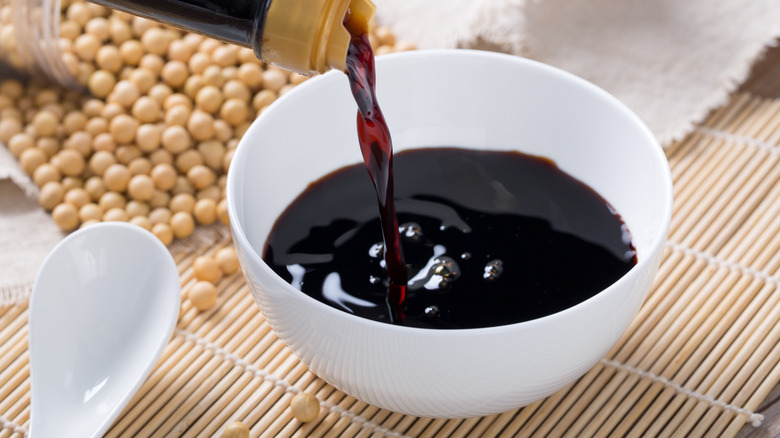Chefs Say You Should Try A Soy Sauce And Fruit Pairing At Least Once
Many people use soy sauce as a substitute for salt in Asian cooking, but the truth is there's much more to the condiment's flavor than just saltiness. In addition to the soybeans and added salt, soy sauce also gets its flavor from roasted wheat grain and koji spores. When combined with water, these ingredients undergo fermentation and aging before being filtered, pressed, and pasteurized. The result is a deeply brown-colored sauce that's not only salty but is also packed with a rich umami flavor.
Depending on the length of aging, ingredient ratios, and additives like sugar, soy sauce can vary in consistency, darkness, and taste. Tamari soy sauce, for example, contains more soybeans than wheat, making it more viscous, stronger in flavor, and ideal for dipping. Shiro shoyu on the other hand has a higher wheat content and therefore has a less intense flavor and color for when you don't want soy sauce to overwhelm your dish. But what type of soy sauce should you use if you're pairing it with fruit? And why would you want to do that in the first place?
Soy sauce and fruit go together better than you'd expect
You're probably used to reserving your soy sauce for sushi rolls and homemade teriyaki sauce, but a splash of it on fruit goes a long way too. While soy sauce typically has savory applications, it also works well with fruit because sweet and salty ingredients are naturally compatible. The reason that other sweet and salty combos, like salted caramel and chocolate-covered pretzels, taste so good isn't just due to the fact that the flavors balance each other out. There's also a chemical reaction at play. Combining sugar and salt causes more taste receptors on the tongue to activate, ultimately intensifying and enhancing the flavors that are present.
When eating fruit with soy sauce, Bon Appétit's Brad Leone recommends using shoyu, or Japanese-style soy sauce. Shoyu is the most basic form of soy sauce. It contains only four ingredients, whereas Chinese soy sauce can have more additives, sometimes no wheat, and is generally sweeter. Indonesian soy sauce is also sweeter and has extra ingredients including ginger and curry leaves. Therefore if you still want the flavor of the fruit to shine, shoyu is the best option.
What fruits pair best with soy sauce?
Eating fruit with soy sauce might not be a popular practice in the U.S., but it isn't uncommon to season fruit with salt in other parts of the world. In the Philippines, for example, mangoes with bagoong, a salty condiment made up of fermented shrimp, is a popular street food. In Mexico, they instead put tajin on their fruits, a seasoning consisting of sea salt, chili peppers, and powdered lime. Finally, in Greece, there's a dish called karpouzi salata — a type of salad made with watermelon and salty feta cheese.
Substitute the bagoong, tajin, or feta for soy sauce, and you'll have an equally delicious flavor combination. Brad Leone recommends strawberries, but realistically any tart or underripe fruit should do, so hold off on the soy sauce on fruits like banana and coconut, and save it instead for ones like kiwi, pineapple, and mango instead. As they say, you can't knock it until you try it, but if you already like sweet and salty foods, there's a good chance you'll end up enjoying soy sauce on fruit.


